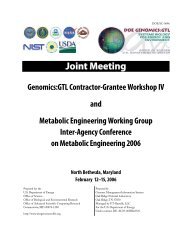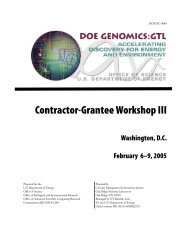Joint Meeting - Genomics - U.S. Department of Energy
Joint Meeting - Genomics - U.S. Department of Energy
Joint Meeting - Genomics - U.S. Department of Energy
You also want an ePaper? Increase the reach of your titles
YUMPU automatically turns print PDFs into web optimized ePapers that Google loves.
26<br />
Systems Biology for DOE <strong>Energy</strong> and Environmental Missions<br />
Our iterative approach <strong>of</strong> integrating experimental data<br />
with model-building enables us to refine genome annotations<br />
and metabolic network maps progressively. We are<br />
currently in the process <strong>of</strong> completing the first <strong>of</strong> such<br />
cycles. Concurrent with carrying on these iterations, we<br />
will develop testable hypotheses to accelerate future biological<br />
discoveries relevant to our goals and those <strong>of</strong> the<br />
C. reinhardtii scientific community at large.<br />
GTL<br />
31<br />
Addressing Unknown Constants and<br />
Metabolic Network Behaviors through<br />
Petascale Computing: Understanding<br />
H Production in Green Algae<br />
2<br />
Christopher H. Chang, 1 * David Alber, 1 Peter Graf, 1<br />
Kwiseon Kim, 1 Arthur R. Grossman, 2 Glenn Murray, 3<br />
Matthew C. Posewitz, 3 and Michael Seibert 1 (mike_<br />
seibert@nrel.gov)<br />
1National Renewable <strong>Energy</strong> Laboratory, Golden,<br />
Colorado; 2Carnegie Institution <strong>of</strong> Washington,<br />
Stanford, California; and 3Colorado School <strong>of</strong> Mines,<br />
Golden, Colorado<br />
Project Goals: Development <strong>of</strong> photobiological<br />
H -production processes, a key component in pursuit<br />
2<br />
<strong>of</strong> DOE’s renewable energy mission, would be substantially<br />
accelerated by increasing our understanding <strong>of</strong><br />
the extremely complex underlying biology. To address<br />
biological complexity at the molecular level, systems<br />
biology has evolved rapidly in recent years. However,<br />
the lack <strong>of</strong> comprehensive experimental data for a given<br />
organism prevents reliable predictive modeling. We<br />
will therefore employ petascale computing to address<br />
this issue by computational parameter estimation to<br />
delimit the space <strong>of</strong> stable solutions for experimentally<br />
constrained metabolic models. The response will be<br />
characterized at the level <strong>of</strong> enzyme kinetic differential<br />
equation parameters. Through development <strong>of</strong><br />
scalable s<strong>of</strong>tware tools, iterative model building, and<br />
incorporation <strong>of</strong> experimental constraints generated<br />
by high-throughput “omics” technologies, a model<br />
<strong>of</strong> metabolism linked to H production in the green<br />
2<br />
alga, Chlamydomonas reinhardtii, will be constructed.<br />
Once a set <strong>of</strong> acceptable kinetic parameters have<br />
been computed, the model will then be used for high<br />
performance optimization <strong>of</strong> H output in the space <strong>of</strong><br />
2<br />
enzyme expression levels, subject to limitations on cell<br />
viability. Integration into the popular Systems Biology<br />
Workbench will make our tools accessible to the<br />
* Presenting author<br />
general user community. The work is envisioned as an<br />
important contribution toward long-term development<br />
<strong>of</strong> a complete in silico cell.<br />
The <strong>Genomics</strong> revolution has resulted in a massive and<br />
growing quantity <strong>of</strong> whole-genome DNA sequences,<br />
which encode the metabolic catalysts and ribonucleic<br />
acids necessary for life. However, gene annotations can<br />
rarely be complete, and measurement <strong>of</strong> the kinetic<br />
constants associated with the encoded enzymes can not<br />
possibly keep pace, necessitating the use <strong>of</strong> careful modeling<br />
to explore plausible network behaviors. Key challenges<br />
are (a) the quantitative formulation <strong>of</strong> the kinetic<br />
laws governing each transformation in a fixed model<br />
network; (b) characterizing the stable solutions <strong>of</strong> the<br />
associated ordinary differential equations; (c) fitting the<br />
latter to metabolomics data as it becomes available; and<br />
(d) optimizing a model output against the possible space<br />
<strong>of</strong> kinetic parameters, with respect to properties such as<br />
robustness <strong>of</strong> network response or maximum consumption/production.<br />
This project addresses this large-scale<br />
uncertainty in the genome-scale metabolic network <strong>of</strong><br />
the water-splitting, H 2 -producing green alga, Chlamydomonas<br />
reinhardtii [1,2]. Each metabolic transformation<br />
is formulated as a steady-state process in such manner<br />
that the vast literature on known enzyme mechanisms<br />
may be incorporated directly. We have encoded glycolysis,<br />
the tricarboxylic acid cycle, and basic fermentation pathways<br />
in Systems Biology Markup Language (SBML)<br />
with careful annotation and consistency with the KEGG<br />
database, yielding a preliminary model with 4 compartments,<br />
85 species, 35 reactions, and 89 kinetic constants.<br />
The SemanticSBML toolkit is first used to combine,<br />
validate, and annotate hand-coded SBML models corresponding<br />
to metabolic modules. In this manner, a<br />
genome-scale kinetic model may be constructed from a<br />
library <strong>of</strong> simple component pathways, making modification<br />
and maintenance plausible. The use <strong>of</strong> a standard,<br />
XML-based language and preservation <strong>of</strong> semantics<br />
in the naming convention for variables and parameters<br />
means that customization <strong>of</strong> the library to any organism<br />
may be accomplished easily. From an instance <strong>of</strong> a model,<br />
use <strong>of</strong> libSBML and SOSLib allows automatic production<br />
<strong>of</strong> a C program that when executed, optimizes<br />
the model’s kinetic parameters according arbitrary test<br />
criteria. The generation <strong>of</strong> this optimizer from the model<br />
consists <strong>of</strong> several steps. First, the unified SBML model<br />
is parsed and converted to a system <strong>of</strong> ordinary differential<br />
equations (ODEs), including Jacobian and sensitivity<br />
matrices. These are then translated to C functions and<br />
embedded in code utilizing the ODE solver package<br />
CVODES, resulting in a library that can efficiently<br />
simulate the model, including calculating derivatives with





